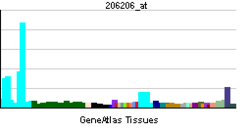CD180
CD180 antigen is a protein that in humans is encoded by the CD180 gene.[3][4][5][6]
CD180 is a cell surface molecule consisting of extracellular leucine-rich repeats (LRR) and a short cytoplasmic tail. It is also known by the archaic terms Bgp-95 and RP105, for the founding designations following discovery in humans (1988) and mice (1994), respectively. The extracellular LRR is associated with a molecule called MD-1 and form the cell surface receptor complex, CD180/MD-1. It belongs to the family of pathogen receptors, Toll-like receptors (TLR). CD180/MD-1, by working in concert with TLR4, controls B cell recognition and signaling of lipopolysaccharide (LPS), a membrane constituent of Gram-negative bacteria.[5]
References
- ↑ "Human PubMed Reference:".
- ↑ "Mouse PubMed Reference:".
- ↑ Miura Y, Shimazu R, Miyake K, Akashi S, Ogata H, Yamashita Y, Narisawa Y, Kimoto M (Nov 1998). "RP105 is associated with MD-1 and transmits an activation signal in human B cells". Blood. 92 (8): 2815–22. PMID 9763566.
- ↑ Miura Y, Miyake K, Yamashita Y, Shimazu R, Copeland NG, Gilbert DJ, Jenkins NA, Inazawa J, Abe T, Kimoto M (Mar 1997). "Molecular cloning of a human RP105 homologue and chromosomal localization of the mouse and human RP105 genes (Ly64 and LY64)". Genomics. 38 (3): 299–304. doi:10.1006/geno.1996.0632. PMID 8975706.
- 1 2 "Entrez Gene: CD180 CD180 molecule".
- ↑ [4]
Further reading
- Honda Y, Yamagiwa S, Matsuda Y, et al. (2007). "Altered expression of TLR homolog RP105 on monocytes hypersensitive to LPS in patients with primary biliary cirrhosis.". J. Hepatol. 47 (3): 404–11. doi:10.1016/j.jhep.2007.03.012. PMID 17448566.
- Divanovic S, Trompette A, Atabani SF, et al. (2005). "Negative Regulation of TLR4 Signaling by RP105". Nat. Immunol. 6 (6): 571–8. doi:10.1038/ni1198. PMC 2144914
 . PMID 15852007.
. PMID 15852007.
- Gerhard DS, Wagner L, Feingold EA, et al. (2004). "The Status, Quality, and Expansion of the NIH Full-Length cDNA Project: The Mammalian Gene Collection (MGC)". Genome Res. 14 (10B): 2121–7. doi:10.1101/gr.2596504. PMC 528928
 . PMID 15489334.
. PMID 15489334.
- Suzuki Y, Yamashita R, Shirota M, et al. (2004). "Sequence Comparison of Human and Mouse Genes Reveals a Homologous Block Structure in the Promoter Regions". Genome Res. 14 (9): 1711–8. doi:10.1101/gr.2435604. PMC 515316
 . PMID 15342556.
. PMID 15342556.
- Zhang Z, Henzel WJ (2005). "Signal peptide prediction based on analysis of experimentally verified cleavage sites". Protein Sci. 13 (10): 2819–24. doi:10.1110/ps.04682504. PMC 2286551
 . PMID 15340161.
. PMID 15340161.
- Izmailova E, Bertley FM, Huang Q, et al. (2003). "HIV-1 Tat reprograms immature dendritic cells to express chemoattractants for activated T cells and macrophages". Nat. Med. 9 (2): 191–7. doi:10.1038/nm822. PMID 12539042.
- Strausberg RL, Feingold EA, Grouse LH, et al. (2003). "Generation and initial analysis of more than 15,000 full-length human and mouse cDNA sequences". Proc. Natl. Acad. Sci. U.S.A. 99 (26): 16899–903. doi:10.1073/pnas.242603899. PMC 139241
 . PMID 12477932.
. PMID 12477932.
- Miyake K, Shimazu R, Kondo J, et al. (1998). "Mouse MD-1, a molecule that is physically associated with RP105 and positively regulates its expression". J. Immunol. 161 (3): 1348–53. PMID 9686597.

 . PMID 15852007.
. PMID 15852007. . PMID 15489334.
. PMID 15489334. . PMID 15342556.
. PMID 15342556. . PMID 15340161.
. PMID 15340161. . PMID 12477932.
. PMID 12477932.